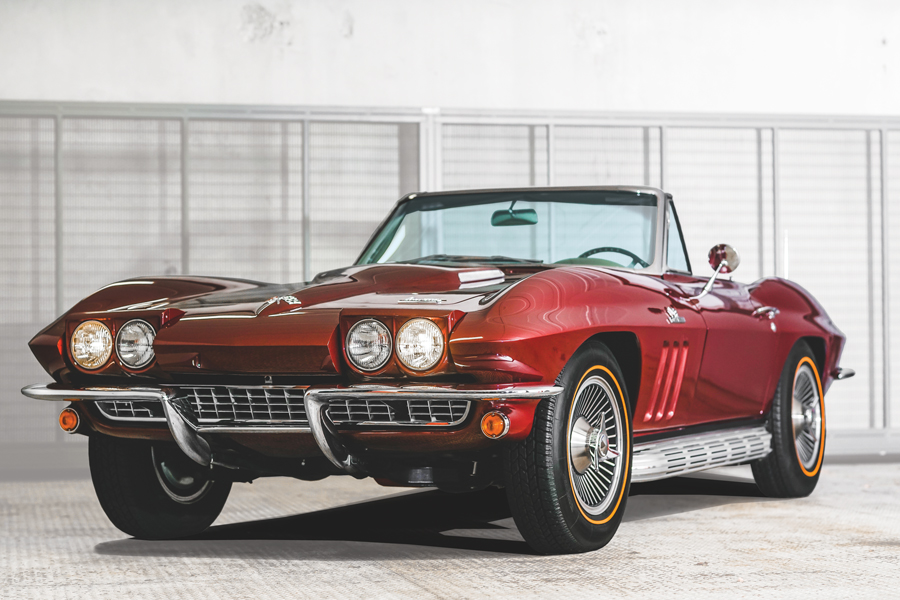- Early-production 427-ci convertible
- Built in October 1965
- L72 engine
- Sidepipes
- Close-ratio M21 4-speed gearbox
- Power steering
- Finned cast-aluminum knockoff wheels
- AM/FM radio
- Removable hard top
- Milano Maroon paint
- Saddle leather interior
SCM Analysis
Detailing
| Vehicle: | 1966 Chevrolet Corvette 427/450 convertible |
| Years Produced: | 1966 |
| Number Produced: | 17,762 |
| Original List Price: | $4,084 |
| SCM Valuation: | $80,500 |
| Tune Up Cost: | $500 (estimated) |
| Chassis Number Location: | Cross brace under glovebox |
| Engine Number Location: | On block in front of right cylinder head |
| Alternatives: | 1958–60 Corvette 283/290 FI; 1965 Corvette 396 L84 convertible; 1967 Corvette 427 L71 convertible |
| Investment Grade: | A |
This car, Lot 114, sold for $120,400, including buyer’s premium, at the RM Sotheby’s auction in Scottsdale, AZ, on January 16, 2020.
Auction houses are like rock climbers, always looking for that small handhold or toehold on a complex surface that allows them to inch upward. But instead of moving toward the apex of a physical climb, the auctioneer pushes toward the highest sale price possible for each unit on offer.
This strategy is abundantly clear in the 1966 Corvette Sting Ray 427 shown here.
The 396-ci big-block V8 debuted in the Corvette for 1965, but its run was one year only, and was followed by the 427 for ’66. There were two 427-ci V8s available during this first 7-liter year. The “base” 427 was the L36 rated at 390 hp, and atop the ladder was the L72, rated initially at 450 hp and then dialed back in “advertised” power to 425 hp — an internal PR decision at Chevrolet that did not invoke any differences to the engine.
Regardless of how much power the 427 actually produced and which Turbo-Jet decal lived on the air-cleaner lid, the L72 was still quite the motor, with a forged crankshaft, hunky 11.0:1 pistons, special rectangular-port heads, a unique camshaft with solid lifters, a big 780-cfm Holley 4-barrel carburetor and more.
A step down the options list, below the base 427 L36, were a pair of 327-ci motors including the entry-level 300-hp mill and the well-regarded L79 with 350 hp. This was a bittersweet year, though, because just as the vaunted 427 debuted, the hypnotic Fuelies were gone.
What does this all mean? The early-build ’66 shown here, outfitted with an L72 motor, tops the 1966 Corvette range.
Rarity wins again
Clearly, with plenty of L72 coupes and convertibles built for 1966 (5,258, to be exact, among a total ’66 production run of 27,720 units — a new record for Corvette), the seller and/or auction house might have felt they needed a hook to hang their hat on for this auction lot. And thus, it was entirely logical to advertise it as a “425/450” car — even though the early “450-hp” L72 and later “425-hp” L72 engines were essentially identical.
Regardless of motive or method, though, judging by the price paid, this was a good call, as the sale price landed an impressive 50% above the ACC Pocket Price Guide’s median value for ’66 L72 convertibles. The result also proved that even though the market is softer now than in recent years, real jewels can still shine onstage.
Perfectly ordinary
Besides offering the top engine for 1966 in a desirable early-production car (with a mint julip of intrigue surrounding the “450/425” issue), this lot is actually a fairly ordinary L72 Corvette — just done to perfection.
The Milano Maroon paint was the second-most-popular for the year (with 3,799 cars so painted, compared with 6,100 Nassau Blue units); and likewise, there were nearly twice as many convertibles as coupes made for ’66 (17,762 and 9,958, respectively). Popular options on this car include a Positraction axle, an AM/FM radio, aluminum knockoff wheels, Goldline tires and an auxiliary hard top.
The paint, chrome, panel fit, sidepipes, wheels and tires, interior, engine and engine bay all look outstanding. Better than as-delivered in late 1965? Likely, but there’s little doubt this is a Condition 1 car — or maybe a 1- due to a few small blemishes. As long as the mechanicals were as closely nurtured as the cosmetics, this would be a complete blast to drive, with its close-ratio Muncie 4-speed transmission and all that torque packed under the domed hood.
Where’s the beef?
Unfortunately, little history was given for this car. Is it numbers matching? Has it always been together as one car, or have such parts as the aluminum wheels, exhaust, doors and hood, seats and instruments, transmission and differential been replaced? And where’s the window sticker or Protect-O-Plate? We don’t know.
Another question is the authenticity and originality of all the replacement components, from seat belts to fan belts, and from hose clamps to headlights.
The National Corvette Restorers Society (NCRS) publishes technical information manuals that make purifying Corvettes a relatively straightforward process. A feather in this car’s cap would’ve been to submit it for NCRS judging prior to sale. A car having earned chapter, regional or national Top Flight honors gives bidders confidence that they are purchasing a high-fidelity ’Vette.
All of the above considered, the sale price of $120,400 for this car seemed very strong indeed. In today’s new collector-car reality, the seller should be pleased. Well done to whoever found, restored and offered this car.
(Introductory description courtesy of RM Sotheby’s.)
